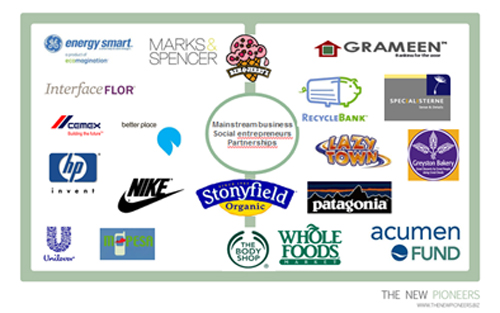
A business force for good
Although the concept of social entrepreneurship to many is much more appealing and sexy than mainstream commercial business, we need the power of both to push the field of socially responsible and socially innovative companies forward.
The new business revolution is, in fact, being driven both top-down from some of the world’s largest companies - and bottom-up from entrepreneurial activists and social changemakers. Because hardcore business people are realizing that they can increase their profits by incorporating social responsibility as a part of their business strategy, and heartcore idealists are recognizing that the use of market methods gives them the opportunity to create even more social value.
To them there is no doubt: the blended value proposition of social, environmental and financial value all being parts of one essential value is the future way of thinking value creation, as already promoted in CSR, social investing (SRI), venture philanthropy and indeed social entrepreneurship.
As a result, both are navigating in the crossfields between business and humanism, although they have different aims and motivation for doing so, ranging from altruism to enlightened self-interest or pure profit-seeking. Together they are contributing to an increasingly powerful ‘business force for good’ that is not only changing the world – it is also changing the face of capitalism to a renewed version where profit is reconciled with our inner values.
With an accelerating convergence between what first-mover corporations are already doing, what mainstream companies are striving to do and what social entrepreneurs are showcasing in their field, there is a growing potential for fruitful ‘cross-fertilization’ through partnerships and upscaling of solutions.
Cooperation and partnerships will infuse all parties involved with new perspectives and new knowledge that may lead to better results than they would be able to create individually.
Big mainstream companies, for example, may gain access to new markets or new product and service innovations or even new business models that build on corporate social innovation more easily and at greater speed, because the smaller social ventures may have spent years or even decades designing, testing and implementing their social innovations as well as building a relationship of trust, local knowledge and credibility amongst their users or customers.
The social ventures, on the other hand, may leverage their innovations with less risk and may release extra capacity to either replicate or even start up more new social ventures because the big companies may provide management skills and resources to explore potential spill-over effects and synergies.
This is how Grameen Bank has succeeded in expanding its microfinance activities into, among other things, communications, technology and nutritional foods with companies like Telenor, Intel and Danone to meet its overall vision of reducing poverty by providing business and employment opportunities.
So if social entrepreneurs and mainstream businesses can overcome the potential barriers and difficulties that may follow because of, for example, differences in values, the amount of capital costs and resources needed to establish and manage the partnership and the patience, perseverance, time and effort that must be invested, such partnerships can result in a multitude of benefits for all involved.
As these two fields of practice continue to evolve it will, however, become increasingly harder to distinguish the two from each other, because social entrepreneurship will become more of a mindset around blended value creation rather than a specific category of start-up companies.
Posted in | CSR, Partnerships, Social entrepreneurship, Social innovations, Sustainable businessTagged | blended value, business force for good, converging fields, corporate social innovation, CSR, Dannone, economic and social value creation, Grameen Bank, hardcore business people, heartcore idealists, Intel, new business models, partnerships between mainstream companies and social entrepreneurs, reducing poverty through business, social entrepreneurship as mindset, social investing, social responsibility as part of business strategy, SRI, Telenor, upscaling of solutions, venture philanthropy
3 Responses
-
I found out about a new training program for the federal government’s Home Energy Score Program. (see http://www.homeenergyscore.gov)
You take a free course, then you take a second course to get certified to work as a Home Energy Score Qualified Assessor. (paid by grant money from the government)
The site to take the course is http://www.spirittechs.com It also has more information about the process, and a free energy auditor course – all online.







Hi,
Really a good website. It will help students like me a lot.
http://greenprateek.blogspot.com